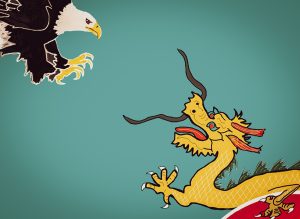
Henna-Riikka Pennanen, Postdoctoral Researcher (TIAS)
I am a bit of a pessimist. It is not that I do not believe things will work out in the end, it is just that I do not think they are likely to work out for the best. Presumably, this vague outlook colors my academic work just as it does my personal life, but how exactly?
Ronald Barnett writes that it is “easy enough to be pessimistic about the character of academic life in the twenty-first century, for there is much to be pessimistic about —” (Academic Working Lives, 2014). The distorted work–life balance, instrumentalism, and auditing and surveillance regimes are merely some of the pessimism-inducing aspects of the academic workplace Barnett recites. Not to mention constant rejections, precarious positions, and the unending competition. In fact, my wonderful pessimist colleagues and I have internalized the mantra of cut-throat competition so well that our favorite pastime is to compete over who thinks they have the least chances of success in landing a grant or getting published. Thus, there is a symbiotic relationship: the academia indulges my pessimism, and then my cynicism and resignation add to the general pessimistic atmosphere. If it were not for my equally wonderful optimist colleagues, I doubt nothing would ever change for the better around here.
My research revolves around pessimism as well. The primary sources I am currently working with are rife with pessimism. This is unsurprising since I am studying U.S. perceptions and representations of rising Japan as a threat to the United States and world peace in the early decades of the twentieth century. In the primary sources of a historian, pessimism comes in many forms: a general philosophy of history as a (often cyclical) process tending to the worse; a philosophical or religious belief that the humanity is the worst or the world they have created is the worst of possible worlds; and skeptical or even alarmist reactions to specific events and intellectual, political, or social currents. Historical pessimism is reflected in “time-consciousness.” That is, the individual or collective consciousness of “a given present in relation to its past and future,” as K. F. Helleiner, Professor of Economic History, argued in an essay in 1942.
For example, in 1919, Thomas Millard predicted a conflict involving China, Japan, and the United States (Democracy and the Eastern question). A journalist and a “China Hand,” Millard speculated on the likely causes of future international conflicts. Drawing from Professor Charles W. Eliot, Millard argued that the causes of war were:
national distrusts, dislikes, and apprehensions, which have been nursed in ignorance, and fed on rumors, suspicions, and conjectures propagated by unscrupulous newsmongers
and
clashing commercial or industrial interests, contests for new markets and fresh opportunities for profitable investments of capital.

Cover page of Millard’s Democracy and the Eastern Question. Public domain.
In addition, there was an ideological element involved. Millard believed that two opposing theories of international polity—namely autocratic militarism and democracy—were drawing nations into conflict in the East, just as these theories had recently battled out in Europe in the Great War. In the Northeast Asia, rising Japan stood for autocratic militarism and China for the “weak and apprehensive democracy.” According to Millard, preventing this coming contest and shielding China from Japanese aggression necessitated “direct and active participation—some say leadership—of America,” if not for any abstract ideological principles, then for U.S. national security and interests.
Sounds eerily familiar, right? Similar gloomy assessments of a coming international conflict involving the United States and a rising—or more accurately, a risen—East Asian power abound today, as does the ideological framing of the conflict in terms of democracy versus autocracy. Only the roles assigned to China and Japan have been reversed, and the historical analogy pundits draw from is the Cold War instead of World War I. Consequently, just as the early twentieth-century U.S. Americans were wondering whether they were destined to fight Japan, the whole world is now speculating on whether China and U.S. are heading towards a new Cold War.
When working with my historian’s hat on, my aim is to understand a historical text in its proper historical context(s). Accordingly, if I wish to assess the time-consciousness of the author as it is reflected in the text, I need to read the text against the context and the collective time-consciousness of the day.
Thus, we can note that as the World War I was briefly followed by liberal optimism for a peaceful future of world affairs, Millard’s prediction of an international conflict appears pessimistic. Then again, the tide of opinion regarding Japan was slowly turning. A reviewer in the American Journal of International Law denounced the book, writing that the author was “frankly and aggressively anti-Japanese” and that “Mr. Millard may be wrong, but he has no doubts.” And yet, the reviewer also noted that while the U.S. observers were “always ready to assume the worst of European monarchies,” some of them were now beginning to have misgivings about Japan, too. In this atmosphere, Millard’s reading of the situation could be judged more generously as realistic, and for example, another reviewer in The Journal of International Relations did not find fault with the book. However, only with the benefit of hindsight can we conclude that Millard was not sounding an alarm for nothing.
Studying history, I can put aside my personal time-consciousness and the collective time-consciousness of my own time. Studying the present, they are more difficult to sidestep. Today, the general mood regarding world affairs is starkly more pessimistic than a hundred years ago. Tim Stevens and Nicholas Michelsen depict pessimism as our Zeitgeist (Pessimism in International Relations, 2020), exacerbated by, for example, the tightening geostrategic competition between China and the United States and fears of democratic backsliding.

Image: Henna-Riikka Pennanen
So, coming back to the debate on whether there will be a new Cold War—and leaving aside the question whether this is a fitting historical analogy in the first place—it would be (far too) easy to find affirmative evidence, and present an analysis confirming my own pessimistic disposition and conforming to the sweeping pessimism of our age. To avoid this, I have come up with two strategies: the (in)famous academic “on the one hand/on the other” and joining forces with optimists. If any of you wonderful pessimists and optimists out there have worked out other strategies to reach nuanced and balanced assessments of the present, please let me know.
